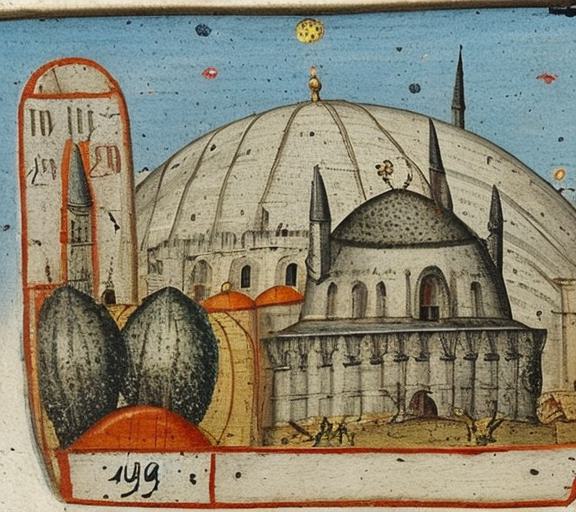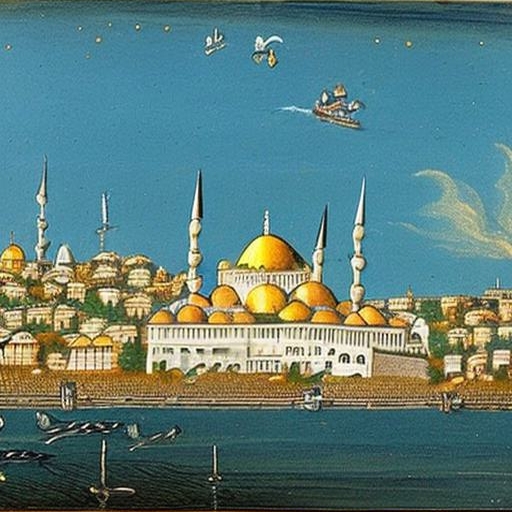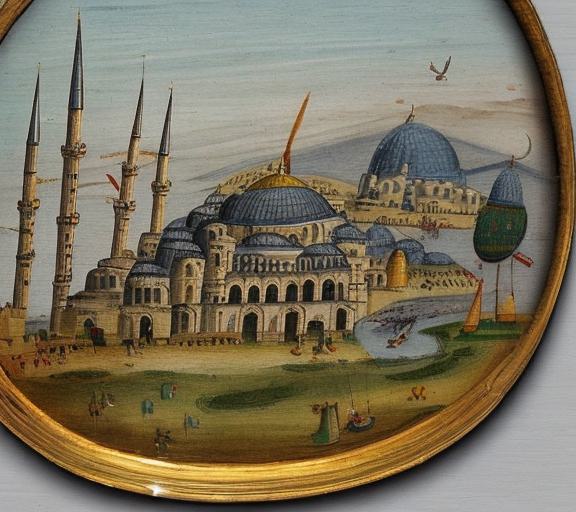uIn the late 16th century, a remarkable scientific project was undertaken in the Ottoman capital of Istanbul: the construction of a large and sophisticated observatory that aimed to rival the achievements of the famous Samarkand observatory of Ulugh Beg. The man behind this ambitious endeavour was Taqi ad-Din Muhammad ibn Ma’ruf, a polymath who excelled in astronomy, mathematics, engineering, mechanics, optics, and natural philosophy. In this blog post, I will tell you the story of his life, his observatory, and his legacy.
The Life of ibn Ma’ruf
Taqi ad-Din was born in Damascus in 1526, into a noble family that claimed descent from the Ayyubids, the dynasty that ruled Egypt and Syria in the 12th and 13th centuries. He received a thorough education in various fields of Islamic sciences, such as theology, jurisprudence, logic, grammar, and rhetoric. He also showed a keen interest in mathematics and astronomy, and studied under several renowned scholars in Damascus and Cairo.
He travelled extensively throughout the Ottoman Empire and beyond, visiting places like Jerusalem, Mecca, Medina, Yemen, Ethiopia, Egypt, Sudan, and India. He learned from different schools of thought and observed various astronomical phenomena. He also acquired many books and manuscripts that enriched his knowledge and inspired his own writings.
In 1571, he was appointed as the chief astronomer of the Ottoman Empire by Sultan Selim II. He moved to Istanbul and began to work on improving the astronomical tables that were used for determining the times of prayer, fasting, festivals, and other religious duties. He also advised the sultan on astrological matters, such as interpreting comets and eclipses.
The Observatory of Istanbul
In 1574, Sultan Murad III succeeded Selim II and invited Taqi ad-Din to build an observatory in Istanbul. The sultan was interested in astronomy and wanted to support scientific research and innovation. He granted Taqi ad-Din a generous budget and a suitable location on a hill overlooking the city.
Taqi ad-Din designed and supervised the construction of the observatory, which was completed in 1577. It consisted of two large buildings: one for housing the library, the staff quarters, and the workshops; and another for hosting the instruments. The instruments included a giant armillary sphere (a model of the celestial sphere), a mechanical clock (for measuring time and planetary motions), a sextant (for measuring angles), a quadrant (for measuring altitudes and azimuths), an astrolabe (for locating stars and planets), and several others. Some of these instruments were invented or improved by Taqi ad-Din himself.
The observatory was equipped with a staff of about 40 astronomers, mathematicians, engineers, craftsmen, and assistants. They worked under the supervision of Taqi ad-Din and followed his research program. They observed the stars and planets regularly and recorded their positions and movements. They also witnessed several remarkable events, such as the Great Comet of 1577 (which Taqi ad-Din described in detail) and three solar eclipses (which he used to calculate the diameter of the sun).
The main goal of the observatory was to produce a new set of astronomical tables that would correct and update the existing ones. Taqi ad-Din named his project “The Tree of Ultimate Knowledge in the Kingdom of the Revolving Spheres: The Astronomical Tables of the King of Kings”. He dedicated it to Sultan Murad III and praised his patronage and support.
The Destruction of The Observatory
The observatory did not survive for very long. In 1580, only three years after its completion, it was destroyed by a decree of Sultan Murad III. The reasons for this decision are not clear, but there are several possible factors that may have contributed to it.
One factor was political. The observatory was seen as a symbol of power and prestige for the sultan and his dynasty. However, it also aroused envy and resentment among some members of the Ottoman elite who felt threatened by its influence or excluded from its benefits. They may have conspired against Taqi ad-Din and his project by spreading rumors or accusations about him or his work.
Another factor was religious. The observatory was mainly used for scientific purposes but it also had some astrological implications. Astrology was a controversial subject among Islamic scholars who debated its validity and permissibility. Some considered it as a legitimate branch of knowledge that could reveal the secrets of God’s creation and providence. Others regarded it as a form of divination that contradicted God’s will and wisdom. They may have opposed the observatory and its activities on the grounds that they were unlawful or harmful.
A third factor was natural causes. The observatory was built on a wooden structure that was vulnerable to fire and decay. It also faced some environmental challenges, such as strong winds, heavy rains, and earthquakes. It may have suffered some damage or deterioration that made it unsafe or unusable.
Whatever the reasons, the observatory was demolished, and its instruments were either destroyed or dispersed. Taqi ad-Din was dismissed from his position and retired to his home in Istanbul. He died in 1585, leaving behind a rich legacy of books and manuscripts that testify to his scientific achievements and contributions.
The Leagcy of ibn Ma’ruf
Taqi ad-Din was one of the most prominent and prolific scientists of the Ottoman Empire and the Islamic world. He wrote more than 90 books on various topics, such as astronomy, mathematics, mechanics, optics, engineering, and natural philosophy. He also invented or improved many instruments and devices that demonstrated his ingenuity and skill.
His observatory was one of the largest and most advanced in the medieval world. It represented a remarkable attempt to revive and reform the tradition of Islamic astronomy that had flourished in earlier centuries. It also showed a curiosity and openness to new ideas and discoveries that were emerging in Europe at the time.
His astronomical tables were the most accurate and comprehensive of his era. They corrected many errors and discrepancies that had accumulated in previous works. They also incorporated new data and methods that improved the calculation of celestial phenomena. They were used by later astronomers in the Ottoman Empire and beyond.
Taqi ad-Din was a pioneer of modern science who deserves more recognition and appreciation. His life, his observatory, and his legacy are fascinating subjects for further study and exploration
.
References
– Wikipedia, “Constantinople observatory of Taqi ad-Din”, https://en.wikipedia.org/wiki/Constantinople_Observatory_of_Taqi_ad-Din
– Wikipedia, “Taqi ad-Din Muhammad ibn Ma’ruf”, https://en.wikipedia.org/wiki/Taqi_ad-Din_Muhammad_ibn_Ma%27ruf
– Waymarking, “First observatory of the Ottoman Empire, Istanbul Observatory”, https://www.waymarking.com/waymarks/wmGPAX_First_observatory_of_the_Ottoman_Empire_Istanbul_Observatory_Istanbul_Turkey
– Ali Al-Qushji and His Contributions to Mathematics and Astronomy. https://muslimheritage.com/ali-al-qushji-and-his-contributions-to-mathematics-and-astronomy/
Tags
Divi Meetup 2019, San Francisco
Related Articles
Unappreciated Greatness
Life and Legacy of Jahangir of the Mughal Empire. Jahangir ruled over one of the largest empires in human history during his lifetime, yet few people outside of South Asia have heard of him. I aim to shed light on the life and legacy of this remarkable figure,...
The Plague Doctor’s Diary
A Personal Account of the Turin Epidemic of 1656. I am writing this diary to record my experiences and observations as a plague doctor in Turin, the capital of the Duchy of Savoy, during the terrible epidemic that has afflicted this city and its surroundings since the...
The Timeless Beauty of Bustan
Unveiling the Secrets of Saadi Shirazi's Masterpiece.In the realm of Persian literature, few works have captured the essence of love, spirituality, and morality quite like Bustan (The Orchard) by Saadi Shirazi. This 13th-century masterpiece has left a lasting impact...
Stay Up to Date With The Latest News & Updates
Explore
Browse your topics of interest using our keyword list.
Join Our Newsletter
Sign-up to get an overview of our recent articles handpicked by our editors.
Follow Us
Follow our social media accounts to get instant notifications about our newly published articles.









